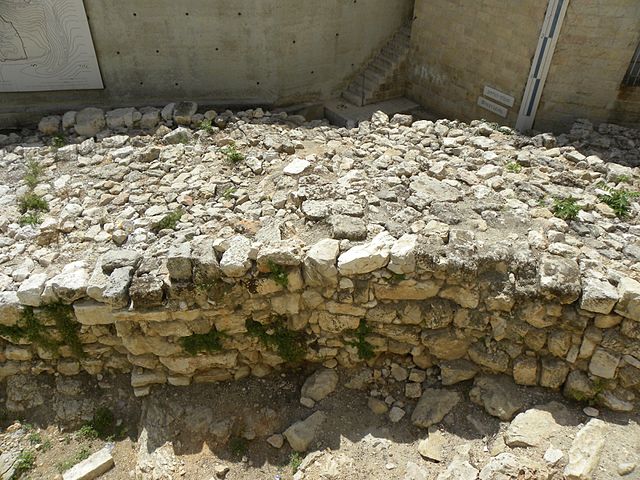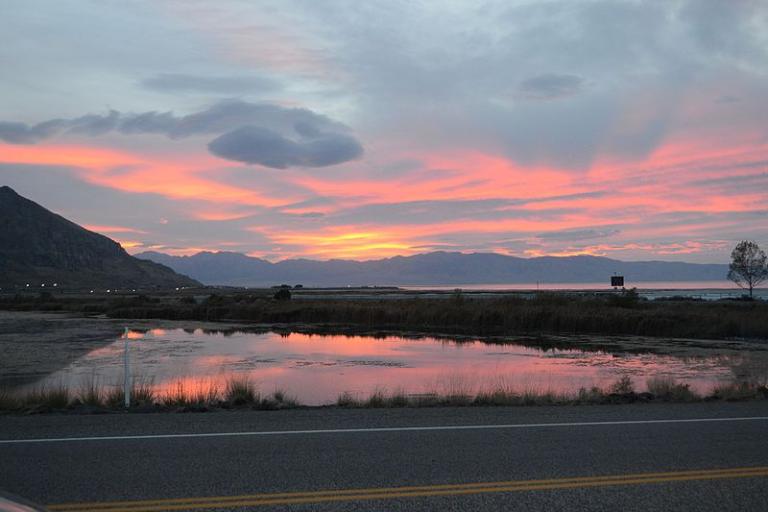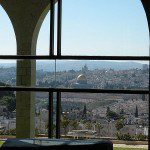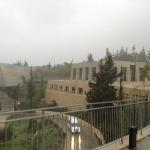
I failed to mention, in my summary post yesterday (“Three Days in Jerusalem”), that we climbed up from the Western Wall Plaza into the Jewish quarter of the Old City as the last act of our Thursday program. We had our meal there — no cheeseburgers! no burger and a shake! — and walked through the quarter over to Zion’s Gate. En route, we had a look at the “Broad Wall,” a portion the city wall that was constructed by the good Judahite king Hezekiah — along with his famous tunnel and water system — in the late eighth century before Christ as part of his preparations for the Assyrian siege that he knew was inevitably coming. (Syria and the Northern Kingdom had already been destroyed.) Unfortunately, although the shape of the wall is still clearly and unmistakably visible, it is currently wrapped in plastic (as it has been, I think, the last couple of times we’ve been here). I have no idea what they’re doing to it, but I hope to see it uncovered when we come again the next time at the very end of October.
This is almost certainly the wall that Lehi and Nephi would have known:
1 Nephi 4:4 –Now when I had spoken these words, they were yet wroth, and did still continue to murmur; nevertheless they did follow me up until we came without the walls of Jerusalem.
1 Nephi 4:5 — And it was by night; and I caused that they should hide themselves without the walls. And after they had hid themselves, I, Nephi, crept into the city and went forth towards the house of Laban.
1 Nephi 4:24 — And I also spake unto him that I should carry the engravings, which were upon the plates of brass, to my elder brethren, who were without the walls.
1 Nephi 4:27 — And he spake unto me many times concerning the elders of the Jews, as I went forth unto my brethren, who were without the walls.
It’s also the wall that so surprised Joseph Smith while he was encountering the Book of Mormon text for the first time while dictating its translation. Here is what the relevant Scripture Central “KnoWhy” has to say about the incident:
During the initial stage of translation of the Book of Mormon in the winter of 1827–1828, Joseph Smith’s wife Emma would often write for him as he translated. Later in life, on multiple occasions, Emma would tell the story of the time Joseph was startled by the mention of walls surrounding Jerusalem at the time of Lehi.Edmund C. Briggs reported the most dramatic version of the story, as he heard it from Emma in 1856.[O]ne time while he was translating he stopped suddenly, pale as a sheet, and said, “Emma, did Jerusalem have walls around it?” When I answered “Yes,” he replied “Oh! I was afraid I had been deceived.” He had such limited knowledge of history at that time that he did not even know that Jerusalem was surrounded by walls.In another account, she said, “He had not read the Bible enough to know that there were walls around Jerusalem,” she remembered in 1877, “and he came and asked me if there were walls around the city of Jerusalem.”David Whitmer, too, later recalled in 1885 “that at the time [of translation] Smith did not even know that Jerusalem was a walled city.”David likely heard the story from Emma since he was not close to the Smith family until 1829, during the final stages of the translation.
Nehemiah 3:8 — Next unto him repaired Uzziel the son of Harhaiah, of the goldsmiths. Next unto him also repaired Hananiah the son of one of the apothecaries, and they fortified Jerusalem unto the broad wall.
Isaiah 22:9-10 — Ye have seen also the breaches of the city of David, that they are many: and ye gathered together the waters of the lower pool. And ye have numbered the houses of Jerusalem, and the houses have ye broken down to fortify the wall.
Today’s visitors to Jerusalem are often confused by the walls around the Old City, imagining them to be the biblical walls of the Old Testament period or, at least, from the time of Jesus. But they are neither. They were built by the Ottoman sultan Suleyman the Magnificent in the early 1500s. That makes them quite old by American standards. But it makes them quite recent by the standards of the Middle East and by Jerusalem itself. As my dear departed friend Bill Hamblin used to say, “Anything after 1500 is journalism.”
Sometimes people base arguments about the location of Christ’s burial on these Ottoman Turkish walls. They point out, quite correctly, that, while the Garden Tomb is outside the city walls, the Church of the Holy Sepulcher is inside those walls, thus ruling it out as a candidate for the burial and resurrection of Jesus. (John 19:20 says that the place where Jesus was crucified was near the city, which presumably means that it wasn’t inside. And Hebrews 13:12 records that Jesus “suffered without the gate,” meaning outside of it.) Anciently, though, both the area of the Garden Tomb and the site of the Holy Sepulcher were just outside the city walls. So that criterion doesn’t disqualify either of them.

But enough of ancient walls around Jerusalem. Let’s get down to something really horrible from the Christopher Hitchens Memorial “How Religion Poisons Everything” File™:











